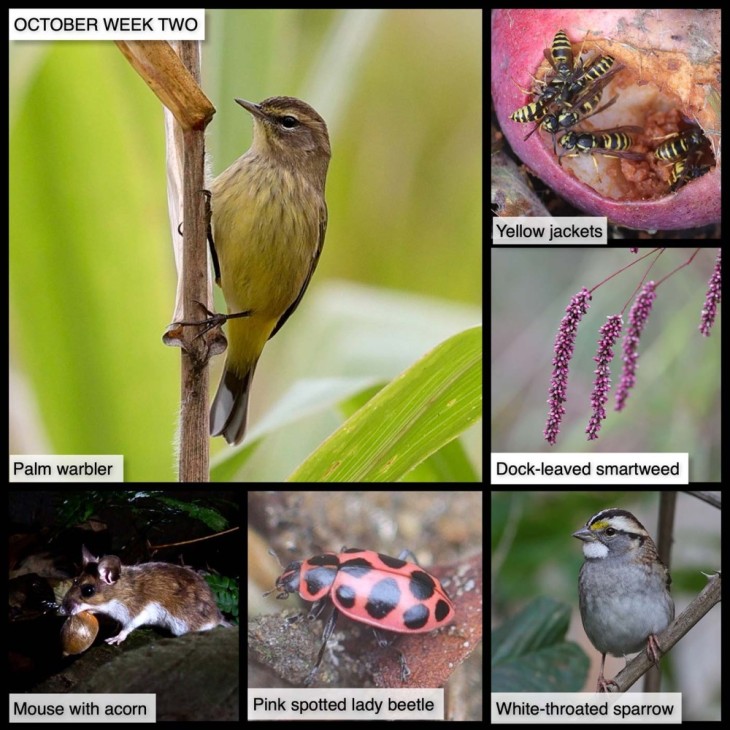This Week in the Woods, we encountered a flock of palm warblers flitting back and forth between a corn field edge and trees along the Ompompanoosuc River. The birds breed in boreal forests, typically in sphagnum bogs, but as noted in this profile from Audubon, during migration they often appear in “old hedgerows, edges of streams and ponds, overgrown fields, and open pastures.”
Here are some other nature sights this week (clockwise):
We found a mass of yellow jackets feeding inside rotting apples in an orchard. As noted in this Outside Story article by Joe Rankin, this time of year, they are no longer hunting insects to feed young wasps, and have precious little to do but eat sugar and await death by frost. As explained by entomologist Jon Turmel, “They’re unemployed. Right now all they want is carbs.”
Dock-leaved smartweed, also called nodding smartweed, is still blooming, and despite its weedy status, it’s very pretty up close. As noted by John Eastman in Field and Roadside, smartweed species’ small flowers lack petals; what you see are the colored sepals. They can self-pollinate, but they also attract an abundance of tiny pollinators. Here’s a profile from the Native Plant Trust.
We’ve been finding flocks of white-throated sparrows, often at field edges, and flying up from stands of gone-to-seed goldenrod. The birds live in our area all year, although we’re probably seeing a lot of recent recruits from Canada. They’re seed eaters, and you’ll often find them in weedy fields. Check out this great post by Jason Hill and Abbie Castriotta for the Vermont Center for Ecostudies, featuring a photo of a white-throated sparrow, which explains why it’s good for nature – including foraging birds – to keep autumn weeds standing and “leaf it be.”
We found this pink spotted ladybeetle, also called twelve-spotted ladybeetle, perched in the flowers of the smartweed described above. Like most ladybeetles, they’re predators that will feed on aphids and other tiny prey, but they also eat pollen, and according to bugguide.net, pink spotteds have the distinction of being “the only North American ladybeetle that can complete its life cycle on plant pollen.” They’ll soon be crawling beneath the leaf litter, overwintering in groups.
Finally, this mouse appeared on a trail cam next to a barn, in the act of carrying an acorn to a cache. Both deer mice and their look-alike cousins, white-footed mice, are active all winter, relying on seeds, nuts, and other cached food, and nesting together to share heat. Or they’ll just come inside. Here’s a fun article by Michael Caduto from our Outside Story series, describing his failed attempts at critter-proofing his old farmhouse, and how he came to terms with thinking of his home as a habitat.
Our thanks to The Bailey Charitable Foundation and the Frank and Brinna Sands Foundation for helping to support this series.
In this difficult period, many of us find joy in observing local nature. This series, launched in April 2020, shares nature photographs taken in the past seven days, or in the same week in 2020, most within 15 miles of the Northern Woodlands office in Lyme, New Hampshire. We hope you enjoy using this grid as a prompt for your own explorations.
What are you seeing in the woods this week? Share your images with us on Facebook, or submit a special photo for possible inclusion in our monthly online Reader Photo Gallery.


